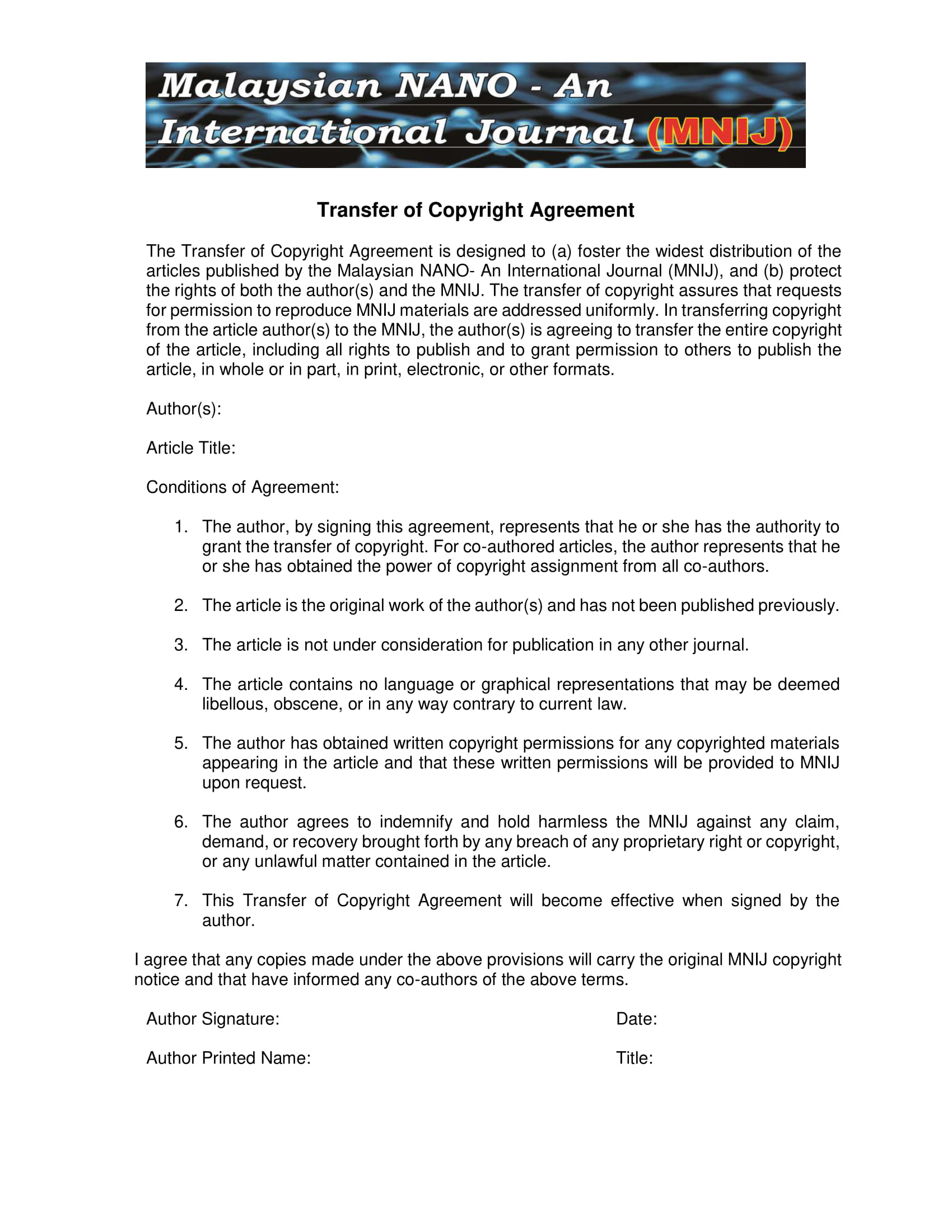Nanocellulose-based carbon nanocomposite for the electrochemical sensing application for pharmaceuticals: A review
DOI:
https://doi.org/10.22452/mnij.vol3no1.1Keywords:
Nanocellulose, carbon nanomaterials, nanocomposite, electrochemical sensing, drugsAbstract
Biopolymers are naturally occurring polymers which have attained profound interest and are investigated widely due to their outstanding characteristics and several advantages such as cost efficiency, hydrophilicity, film formation capability, chemical inertness, non-toxicity, high mechanical integrity and biocompatibility. Cellulose is the most abundant biopolymer in the world. Nanocellulose (NC) is a cost-efficient, biodegradable, eco-friendly, biocompatible and abundant, renewable biomaterial obtained from cellulose by nanoscale isolation. The most interesting property of NC as the precursor material, is that it does not possess hierarchical structural defect. Recently, the incorporation of NC into electroconductive platforms i.e., nanostructured carbon nanocomposite is a hot topic for researchers. NC is not an electroconductive material but an ionic conductor. Availing this property NC can be incorporated with carbon-based materials. CNTs is a carbon-based material with excellent electronic properties, high electroconductive and mechanical properties. This review focuses on the application of nanocomposites containing NC and carbon nanostructured especially CNTs and their properties and sensing applications.
Downloads
References
M Shalauddin et al. Hybrid nanocellulose/f-MWCNTs nanocomposite for the electrochemical sensing of diclofenac sodium in pharmaceutical drugs and biological fluids. Electrochim. Acta. 304, 323-333. (2019)
A Hashem et al., Applications of nanocellulose as biosensing platforms for the detection of functional biomacromolecules: A Review. Malaysian NANO-An International Journal. 2,1; 15-45. (2022)
C Sasso et al., Highly conducting polypyrrole/cellulose nanocomposite films with enhanced mechanical properties. Macromol Mater Eng. 295,10; 934-941. (2010)
JM Malho et al., Facile method for stiff, tough, and strong nanocomposites by direct exfoliation of multilayered graphene into native nanocellulose matrix. Biomacromolecules. 13,4;1093-1099. (2012)
H Koga et al., Transparent, conductive, and printable composites consisting of TEMPO-oxidized nanocellulose and carbon nanotube. Biomacromolecules. 14,4; 1160-1165. (2013)
M Shalauddin et al., Bio-synthesized copper nanoparticle decorated multiwall carbon nanotube- nanocellulose nanocomposite: An electrochemical sensor for the simultaneous detection of acetaminophen and diclofenac sodium. Surf. Interfaces. 34, 102385. (2022)
M Shalauddin et al., Immobilized copper ions on MWCNTS-Chitosan thin film: Enhanced amperometric sensor for electrochemical determination of diclofenac sodium in aqueous solution. Int. J. Hydrog Energy. 42,31; 19951-19960. (2017)
S Akhter et al., Enhanced amperometric detection of paracetamol by immobilized cobalt ion on functionalized MWCNTs-Chitosan thin film. Anal. Biochem. 551, 29-36. (2018)
S Akhter et al. Hybrid nanocomposite of functionalized multiwall carbon nanotube, nitrogen doped graphene and chitosan with electrodeposited copper for the detection of anticancer drug nilutamide in tablet and biological samples. Mater. Chem. Phys. 253,123393. (2020)
M Shalauddin et al., Carboxylated nanocellulose dispersed nitrogen doped graphene nanosheets and sodium dodecyl sulfate modified electrochemical sensor for the simultaneous determination of paracetamol and naproxen sodium. Measurement. 194,110961. (2022)
S Akhter et al. Tri-metallic Co-Ni-Cu based metal organic framework nanostructures for the detection of an anticancer drug nilutamide. Sens. Actuator A Phys. 325, 112711. (2021)
NK Shrestha, X Du, and J Wang. Assessing climate change impacts on fresh water resources of the Athabasca River Basin, Canada. Sci. Total Environ. 601, 425-440. (2017)
F Markoulidis et al. Composite electrodes of activated carbon and multiwall carbon nanotubes decorated with silver nanoparticles for high power energy storage. J. Compos. Sci. 3,4; 97. (2019)
H Kargarzadeh et al. Handbook of nanocellulose and cellulose nanocomposites. Wiley Online Library. (2017)
X Xiong et al. Sources and distribution of microplastics in China's largest inland lake–Qinghai Lake. Environ. Pollut. 235, 899-906. (2018)
K Hettrich et al. Novel aspects of nanocellulose. Cellulose. 21,4; 2479-2488. (2014)
Y Wang et al. Study on nanocellulose by high pressure homogenization in homogeneous isolation. Fibers Polym. 16,3;572-578. (2015)
JH Kim et al. Review of nanocellulose for sustainable future materials. Int. J. Pr. Eng. Man.-GT. 2, 2; 197-213. (2015)
M Rosa et al. Cellulose nanowhiskers from coconut husk fibers: Effect of preparation conditions on their thermal and morphological behavior. Carbohydr. Polym. 81,1;83-92. (2010)
F Wesarg et al. In situ synthesis of photocatalytically active hybrids consisting of bacterial nanocellulose and anatase nanoparticles. Langmuir. 28, 37; 13518-13525. (2012)
H Wang et al. A comparison study on the preparation of nanocellulose fibrils from fibers and parenchymal cells in bamboo (Phyllostachys pubescens). Ind. Crops Prod. 71, 80-88. (2015)
S Mondal. Preparation, properties and applications of nanocellulosic materials. Carbohydr. Polym.163, 301-316. (2017)
F Niu et al. The characteristic and dispersion stability of nanocellulose produced by mixed acid hydrolysis and ultrasonic assistance. Carbohydr. Polym. 165, 197-204. (2017)
J Zhang et al. Facile synthesis of spherical cellulose nanoparticles. Carbohydr. Polym. 69,3; 607-611. (2007)
S Taokaew et al. Biosynthesis and characterization of nanocellulose-gelatin films. Materials. 6,3; 782-794. (2013)
M Shalauddin et al. Immobilized copper ions on MWCNTS-Chitosan thin film: Enhanced amperometric sensor for electrochemical determination of diclofenac sodium in aqueous solution. Int. J. Hydrog. Energy. 42,31; 19951-19960. (2017).
H Bagheri et al. Composite of Cu metal nanoparticles-multiwall carbon nanotubes-reduced graphene oxide as a novel and high performance platform of the electrochemical sensor for simultaneous determination of nitrite and nitrate. J. Hazard. mater. 324,762-772. (2017)
J Li and EC Lee. Functionalized multi-wall carbon nanotubes as an efficient additive for electrochemical DNA sensor. Sens. Actuators B Chem. 239, 652-659. (2017)
V Gautam, KP Singh and VL Yadav. Polyaniline/multiwall carbon nanotubes/starch nanocomposite material and hemoglobin modified carbon paste electrode for hydrogen peroxide and glucose biosensing. Int. J. Biol. Macromol. 111, 1124-1132. (2018)
BK Shrestha et al. Bio-inspired hybrid scaffold of zinc oxide-functionalized multi-wall carbon nanotubes reinforced polyurethane nanofibers for bone tissue engineering. Mater. Des. 133, 69- 81. (2017)
S Mallakpour and S Soltanian. Surface functionalization of carbon nanotubes: fabrication and applications. RSC Adv. 6,111; 109916-109935. (2016)
M Shalauddin et al. A metal free nanosensor based on nanocellulose-polypyrrole matrix and single- walled carbon nanotube: experimental study and electroanalytical application for determination of paracetamol and ciprofloxacin. Environ. Nanotechnol. Monit. Manag. 18, 100691. (2002)
C Wan et al. Recent progress in flexible nanocellulosic structures for wearable piezoresistive strain sensors. J. Mater. Chem. C. 9,34; 11001-11029. (2021)
Z Weng et al. Graphene–cellulose paper flexible supercapacitors. Adv. Energy Mater. 201,5; 917-922. (2011)
S Akhter et al. A highly selective bifunctional nanosensor based on nanocellulose and 3D polypyrrole decorated with silver-gold bimetallic alloy to simultaneously detect methotrexate and ciprofloxacin. Sens. Actuators B Chem. 373, 132743. (2022)
G Nystrom et al. A nanocellulose polypyrrole composite based on microfibrillated cellulose from wood. J. Phys. Chem. B. 114,12; 4178-4182. (2010)

Downloads
Published
How to Cite
Issue
Section
License





